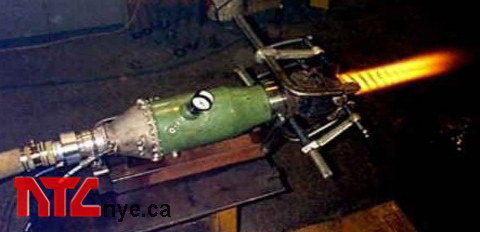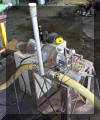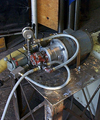Hornet
The Hornet Project.

The following is a brief review of the "Hornet Project". The core of the Hornet is a converted combustor can from a Rolls-Royce Dart turboprop engine. The idea was to create a powerful hot air blowing device with no moving parts that could be used for snow removal and ice melting on the railway. The Hornet uses diesel fuel and a standard rental air compressor rather than an exotic aircraft turbine as the prime mover.


This is the 750 cfm diesel air compressor.


This is the operators station. The vertical bar is the throttle, it's connected to a 2" full flow ball valve. The 1 hp motor, pump valves and gauges are part of the fuel delivery and control system.

This is the Hornet. Air from the throttle valve enters through the yellow hose and 2" aluminum coupling at the far end. Noise, smoke and hot air come out the other.



Here is the back end of the combustor. Note the pressure gauge on top of the air casing. The Hornet is securely mounted and anchored to the floor, it produces around 300 lbs of thrust at full power. The small black hydraulic hose is the fuel line.



The sound this thing makes is deafening. I have heard a lot of things in my life, but nothing like this. The ignition exciter is the small silver box in the foreground. Notice the CO2 fire extinguisher, we always keep one handy incase we blow a fuel line or something.


My bother Steve at the controls getting his jollies!
![]()
This is the exhaust plume, as you can see by the mach diamonds, it is totally super sonic. It can cut a 2 X 4 in half in around 12 seconds. (I know because we tried it).
The "YF-22" Nozzle.


This shows how we use a drill bit to measure and adjust the exit area of our "YF-22" style nozzle.

The nozzle has a threaded adapter so it can be removed easily. We needed all these clamps to keep the nozzle doors from blowing open.




Here is the Hornet in action with the YF-22 nozzle. Chamber pressure is around 50 psi. When we closed the nozzle down to build more pressure it produced a lot of black smoke.



This gives a good idea of how long the flame is at full power.
Check out this video of the Hornet in operation.
The huge volume of smoke followed by a bang and burst of thrust is produced by injecting unburned fuel into the hot combustor then igniting it with the spark igniter.
Here is a narrated video describing the Hornet's construction:
For more information about the Hornet Project contact
Special thanks to:
